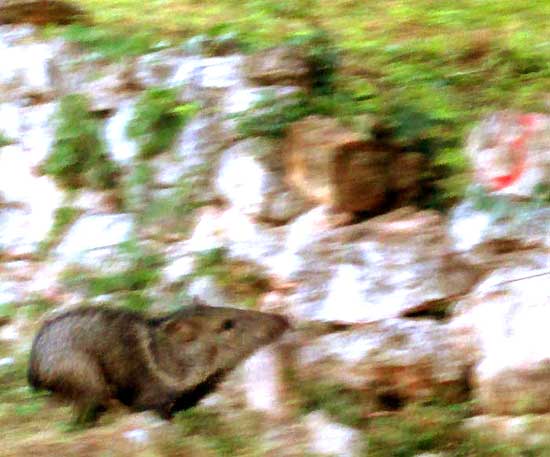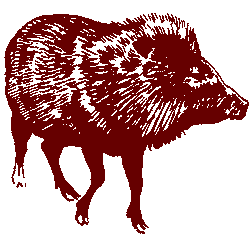Excerpts from Jim Conrad's
Naturalist Newsletter
Entry issued on December 5, 2019, from the forest just west of Tepakán; elev. ~9m (~30 ft), N21.053°, W89.052°; north-central Yucatán state, MÉXICO
PECCARIES IN TOWN
One morning at about 9:30AM I was hiking down Tepakán's westernmost street when, about 70ft (20m) in front of me, two Collared Peccaries unhurriedly emerged from the fallow cornfield on my left, crossed the asphalt, approached a stone wall on the right, and the first peccary leaped through a breech in the wall. By this time I had the camera out and just managed a blurred "shot from the hip" to get the picture shown below, at the moment when the second peccary was tensing to propel himself through the same hole.

Seeing two wild peccaries in town seemed extraordinary, though maybe it wasn't. Peccaries seem to favor foraging during the fresh morning hours, so that was normal. But the main doubt keeping me from proclaiming a full-fledged wondrous observation is that I've read that the Mexican government has a program to encourage folks like those in Tepakán to pen up and feed peccaries as if they were hogs, for eating. These two peccaries were headed right toward Maya homes not far away, so maybe they'd escaped,or had been raised in pens and now after feeding in the woods were returning home to the pen to be fed. I can't find anyone who knows about such a program, though.
Collared Peccaries, PECARI TAJACU, are distributed from the arid southwestern US south through Mexico and Central America to northern Argentina in South America. Several subspecies are recognized, and ours is the Yucatan Collared Peccary, Pecari tajacu yucatanensis. Though most people assume that peccaries are pigs, pigs and peccaries belong to entirely different familes -- pigs in the Suidae, peccaries in the Tayassuidae.
In the wild, peccaries normally feed on cactus, fruits, roots, tubers, grasses, invertebrates and small vertebrates, and if they're in the right place, palm nuts and Mesquite beans. Where people exist, they also eat cultivated crops and ornamental plants.
Peccaries live in groups of up to 50 individuals, though six to nine is more typical. They sleep in burrows, often under tree roots, as well as in caves and under logs. I understand that in the Yucatan the main peccary-hunting technique is for a group of men with their dogs to encircle an area, start making noise, and close in on the prey. Probably there are laws against this, but there is no enforcement to be seen.
Excerpted from Jim Conrad's online book Spring Comes to the Desert Southwest, story written on February 10, 1988 in Big Bend National Park, Texas, USA
 Sometimes a story stays with you all out of proportion to its importance. Such a story once was told to me by an old Maya Indian with whom I was working in the tropical lowlands of northern Guatemala. In that lush, exotic jungle full of poisonous snakes, big wildcats and streambank crocodiles, my friend told me that in the jungle the thing he most feare was the Javalina -- the wild pig my mammal books refer to as the peccary. Vividly I remember Don Antonio saying:
Sometimes a story stays with you all out of proportion to its importance. Such a story once was told to me by an old Maya Indian with whom I was working in the tropical lowlands of northern Guatemala. In that lush, exotic jungle full of poisonous snakes, big wildcats and streambank crocodiles, my friend told me that in the jungle the thing he most feare was the Javalina -- the wild pig my mammal books refer to as the peccary. Vividly I remember Don Antonio saying:
"Usually those pigs run from you. Problem is, they're unpredictable, or maybe just stupid. You surprise a herd and they're just as likely to run at you as away from you. They have tusks that can rip your legs apart. If they knock you down, they can cut your whole body to shreds. And if you ever get between a mama javalina and her piglets, well compadre, you better just say your Hail Mary's!"
So today I'm walking down a dry, rocky canyon not half a mile southwest of Panther Junction Park Headquarters. Suddenly I feel the ground being jarred and I hear gravel being knocked loose. One big peccary scrambles up the slope to the right; six smaller peccaries scramble up the slope to the left. That must be mama on the right and at least one or two of those piglets on the left must be hers, and I don't even know what a Hail Mary is.
The smaller ones stop about thirty feet away while Mama stands less than twenty. Mama turns her side toward me, raises the coarse gray/black hair on her back like a tomcat getting ready to fight, and emits a strong, skunky odor.
In situations like this with large dogs, always I hold my ground and make a noise. That's what I do now. I stand in one spot, clap my hands and yell. And then the whole troupe of tuskers runs away.
End of story...